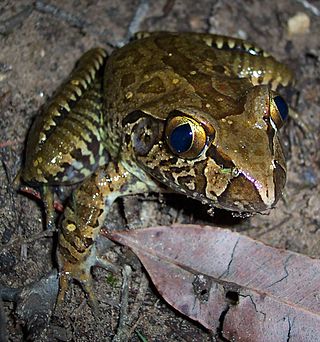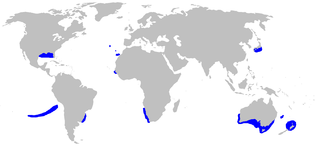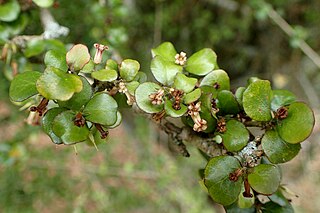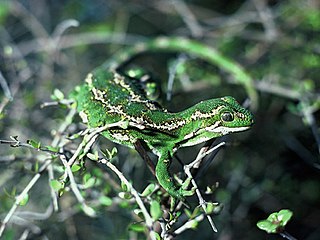
Conondale National Park is 130 km north of Brisbane in the Sunshine Coast Hinterland near the town of Conondale in the south east Queensland bioregion. The park covers an area of 35,648 hectares protecting large areas of subtropical rainforest, woodlands, wet and dry sclerophyll forest including Queensland's tallest tree. The park contains areas of regenerating forest which have been previously logged; areas of forest plantations also border the park. The park is currently managed by the Queensland Government under the Nature Conservation Act 1992.

Powelliphanta is a genus of large, air-breathing land snails, pulmonate gastropods in the family Rhytididae, found only in New Zealand. They are carnivorous, eating invertebrates, mostly native earthworms. Often restricted to very small areas of moist forest, they are prey to introduced mammalian predators, and many species are threatened or endangered.

The magenta petrel, or Chatham Island tāiko, is a small seabird in the gadfly petrel genus, Pterodroma. Found exclusively on Chatham Island, New Zealand it is one of the rarest birds in the world, believed to be extinct for over 100 years before its rediscovery in the 1970s.

The New Zealand greater short-tailed bat is one of two species of New Zealand short-tailed bats, a family (Mystacinidae) unique to New Zealand. Larger than the New Zealand lesser short-tailed bat, there have been no confirmed sightings of this species since 1965 and it is considered to be critically endangered, if not extinct. In prehistoric times it lived in the North and South Islands but by the time of European arrival was restricted to small islands near Stewart Island/Rakiura. A rat invasion of Taukihepa/Big South Cape Island in 1963 was thought to have led to the species' extinction, however, recent surveys have raised hopes that the species may still exist.

The conservation status of a group of organisms indicates whether the group still exists and how likely the group is to become extinct in the near future. Many factors are taken into account when assessing conservation status: not simply the number of individuals remaining, but the overall increase or decrease in the population over time, breeding success rates, and known threats. Various systems of conservation status are in use at international, multi-country, national and local levels, as well as for consumer use such as sustainable seafood advisory lists and certification. The two international systems are by the International Union for Conservation of Nature (IUCN) and The Convention on International Trade in Endangered Species of Wild Fauna and Flora (CITES).

Conservation in New Zealand has a history associated with both Māori and Europeans. Both groups of people caused a loss of species and both altered their behaviour to a degree after realising their effect on indigenous flora and fauna.

The New Zealand long-tailed bat, also known as the long-tailed wattled bat is one of 15 species of bats in the genus Chalinolobus variously known as "pied bats", "wattled bats" or "long-tailed bats". It is one of the two surviving bat species endemic to New Zealand, but is closely related to five other wattled or lobe-lipped bats in Australia and elsewhere. It was named the winner in the 2021 Bird of the Year competition in New Zealand, despite not being a bird.

The longnose velvet dogfish is a sleeper shark of the family Somniosidae, found circumglobally in southern hemisphere subtropical seas, at depths of between 230 and 1,500 m. It reaches a length of 130 cm. It has a diet consisting of predominantly mesopelagic fishes and squids.

The roughskin dogfish is a sleeper shark of the family Somniosidae, found around the world on continental shelves in tropical, subtropical and temperate seas, at depths of between 100 and 1,500 m. It reaches a length of 121 cm.

The Chatham parakeet, also known as Forbes' parakeet, is a rare parakeet endemic to the Chatham Islands group, New Zealand. This parakeet is one of New Zealand's rarest birds and is classified as Vulnerable on the IUCN Red List, as a result of a range of threats to the species survival, including habitat loss, predation, and hybridization. A number of conservation methods have been employed to assist the recovery of this species, and currently the population trend is considered stable.

The Chatham pigeon, also called the Chatham Island pigeon or parea, is a bird endemic to the Chatham Islands in New Zealand. Growing to 800g in weight and 55 cm in length, the Chatham Island pigeon is closely related to the kererū or New Zealand pigeon, the only other species in the genus Hemiphaga.

Olearia hectorii is a species of flowering plant in the daisy family Asteraceae. Its common names include deciduous tree daisy and Hector's tree daisy. It is endemic to New Zealand, where it is nationally endangered.

Pittosporum obcordatum, commonly called heart-leaved kohuhu or heart-leaved kohukohu or kohukohu, is a species of plant in the Pittosporaceae family. It is endemic to New Zealand, and exists both in North Island and South Island.

Pittosporum turneri, commonly called Turner's kohuhu or the tent pole tree, is a species of plant in the Pittosporaceae family. It is endemic to New Zealand. P. turneri was first described by Donald Petrie in 1925. The species flowers between the months of October to December. P. turneri is threatened by possums. It is regarded as being Nationally Vulnerable.

The jewelled gecko is a threatened species of lizard in the family Diplodactylidae. The species is endemic to the South Island of New Zealand.

The New Zealand Threat Classification System is used by the Department of Conservation to assess conservation priorities of species in New Zealand.

The New Zealand parrot family, Strigopidae, consists of at least three genera of parrots – Nestor, Strigops, the fossil Nelepsittacus, and probably the fossil Heracles. The genus Nestor consists of the kea, kākā, Norfolk kākā and Chatham kākā, while the genus Strigops contains the iconic kākāpō. All extant species are endemic to New Zealand. The species of the genus Nelepsittacus were endemics of the main islands, while the two extinct species of the genus Nestor were found at the nearby oceanic islands such as Chatham Island of New Zealand, and Norfolk Island and adjacent Phillip Island.

Deinacrida carinata, also known as the Herekopare wētā or Foveaux wētā is one of the smallest of the 11 species of giant wētā that belong to the genus Deinacrida, and is a member of the Anostostomatidae family. It is endemic to New Zealand and is currently restricted to a few offshore predator free islands: Herekopare Island, Kundy Island, Tihaka/Pig Island and Whenua Hou/Codfish Island. D.carinata is a protected species and is nationally endangered.

New Zealand is geographically isolated, and originally lacked any mammalian predators, hence parrots evolved to fill habitats from the ground dwelling kākāpō to the alpine dwelling kea as well as a variety of forest species. The arrival of Māori, then European settlers with their attendant animals, habitat destruction and even deliberate targeting, has resulted in their numbers plummeting. Today one species is on the brink of extinction and three other species range from Vulnerable to Critically Endangered, all impacted by invasive species. Further parrot species were not introduced by acclimatisation societies, but occasional releases, both deliberate and accidental, have resulted in self-sustaining populations of some Australian species. New Zealand was identified among the highest priority countries for parrot conservation in the world, due to its parrot diversity, endemism, threats, and having more threatened parrot species than expected.





















